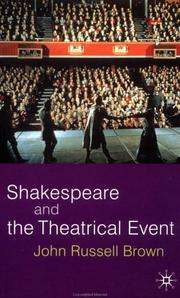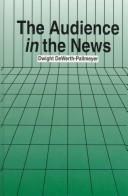| Listing 1 - 10 of 1212 | << page >> |
Sort by
|
Book
ISBN: 9781032539744 Year: 2024 Publisher: Abingdon, England : Routledge,
Abstract | Keywords | Export | Availability | Bookmark
 Loading...
Loading...Choose an application
- Reference Manager
- EndNote
- RefWorks (Direct export to RefWorks)
This accessible guide through audience studies’ histories outlines a contemporary Cultural Studies approach to audiences for the digital age. This book is not a survey of all existing audience research. Instead, its chapters survey parts of the field in order to draw some ‘through-lines’ from older traditions to contemporary debates, giving students a ‘way in’ to thinking about the current landscape from an ‘audience-sensitive’ perspective. In order to do this, the book utilises a series of verbs to organise and cut a path through audience research and register its ongoing relevance today. These verbs are: audience, anchor, mean, feel and work. The list is not exhaustive and the reader is invited to think about what verbs they would add or change throughout the book. Audience suggests renewing the importance of ‘form’ as a cultural process and in ‘circling-back’ to Cultural Studies’ ‘circuit of culture’, it proposes a modified framework for ‘the digital circuit’. Each chapter opens with a particular scenario for the reader to reflect upon and asks a specific question to help orient the account of research that is to come, especially for those new to Media and Cultural Studies and to audience studies. Written in an engaging and accessible style, this book is ideal for both students and researchers of Media and Cultural Studies.--
Audiences. --- Mass media --- Audiences
Book
ISBN: 9781107101111 Year: 2015 Publisher: Cambridge, United Kingdom : Cambridge University Press,
Abstract | Keywords | Export | Availability | Bookmark
 Loading...
Loading...Choose an application
- Reference Manager
- EndNote
- RefWorks (Direct export to RefWorks)
Logic. --- Audiences. --- Audiences. --- Logic.
Book
ISBN: 9781506397405 1506397409 Year: 2020 Publisher: Los Angeles (Calif.) : Sage,
Abstract | Keywords | Export | Availability | Bookmark
 Loading...
Loading...Choose an application
- Reference Manager
- EndNote
- RefWorks (Direct export to RefWorks)
"Whether we are watching TV, surfing the Internet, listening to our iPods, or reading a novel, we are all engaged with media as a member of an audience. Despite the widespread use of this term in our popular culture, the meaning of the "audience" is complex, and it has undergone significant historical shifts as new forms of mediated communication have developed from print, telegraphy, and radio to film, television, and the Internet. Media Audiences explores the concept of media audiences from four broad perspectives: as "victims" of mass media, as market constructions & commodities, as users of media, and as producers & subcultures of mass media. The goal of the text is for students to be able to think critically about the role and status of media audiences in contemporary society, reflecting on their relative power in relation to institutional media producers."--
Mass media --- Audiences. --- Audiences --- Mass media - Audiences
Book
ISBN: 0405117760 Year: 1979 Publisher: New York (N.Y.) : Arno press,
Abstract | Keywords | Export | Availability | Bookmark
 Loading...
Loading...Choose an application
- Reference Manager
- EndNote
- RefWorks (Direct export to RefWorks)
Book
Year: 1971 Publisher: Wien : Böhlau,
Abstract | Keywords | Export | Availability | Bookmark
 Loading...
Loading...Choose an application
- Reference Manager
- EndNote
- RefWorks (Direct export to RefWorks)
Book
Year: 1995 Publisher: Carson, Calif. : National Endowment for the Arts,
Abstract | Keywords | Export | Availability | Bookmark
 Loading...
Loading...Choose an application
- Reference Manager
- EndNote
- RefWorks (Direct export to RefWorks)

ISBN: 0333801318 Year: 2002 Publisher: Houndmills ; New York Palgrave MacMillan
Abstract | Keywords | Export | Availability | Bookmark
 Loading...
Loading...Choose an application
- Reference Manager
- EndNote
- RefWorks (Direct export to RefWorks)
Book
Year: 1968 Publisher: Durham Duke University Press
Abstract | Keywords | Export | Availability | Bookmark
 Loading...
Loading...Choose an application
- Reference Manager
- EndNote
- RefWorks (Direct export to RefWorks)

ISBN: 0805821112 0805821104 9780805821116 9780805821109 Year: 1997 Publisher: Mahwah, N.J. Erlbaum
Abstract | Keywords | Export | Availability | Bookmark
 Loading...
Loading...Choose an application
- Reference Manager
- EndNote
- RefWorks (Direct export to RefWorks)
Journalism --- News audiences --- News audiences.
Book
ISBN: 9783631866030 3631866038 Year: 2022 Publisher: Bern : Peter Lang Verlag AG
Abstract | Keywords | Export | Availability | Bookmark
 Loading...
Loading...Choose an application
- Reference Manager
- EndNote
- RefWorks (Direct export to RefWorks)
The book focuses on two perspectives : the scenological and the literary, and the visions of the spectator and those of the reader. If we refer to the spectator as the one who sees, the orientation is in the angle of the scene, but when the invocations happen in the field of the dramatic text or of different experiences of literature, another central figure appears, that of the reader. The one who reads literature is also a spectator. So what relationships and differences are established in the dynamics of spectators and readers ? If this spectator/reader is absent or not perceptible, does the cultural model of the scenic or literary representation in which both are assumed make sense ? Is the spectator a real body, and is the reader an invisible body ? Or are these bodies just two entities of meaning that modernity has forged to connote its cultural stability ?
| Listing 1 - 10 of 1212 | << page >> |
Sort by
|

 Search
Search Feedback
Feedback About UniCat
About UniCat  Help
Help News
News